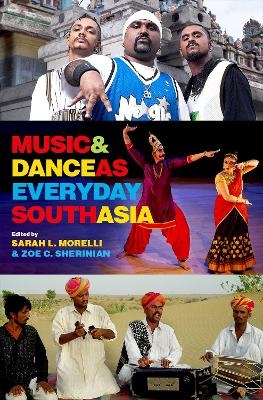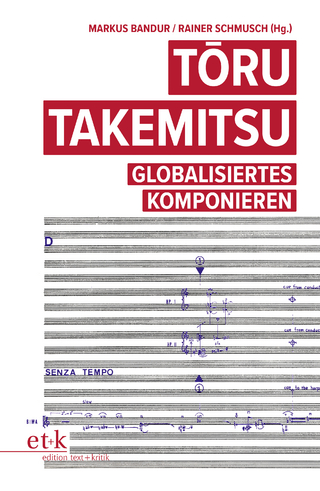
Music and Dance as Everyday South Asia
Oxford University Press Inc (Verlag)
978-0-19-756623-7 (ISBN)
Music and Dance as Everyday South Asia offers an inclusive lens through which to study the music, dance, and allied arts of South Asia, its diasporas, and the people who produce and use these cultural expressions. The authors in this collection--ethnomusicologists, dance scholars, anthropologists, and practitioners--understand music and dance as everyday lived experience. "The everyday" comprises practices of South Asians in multiple countries, whose identities include numerous castes, classes, tribes, genders, sexualities, religions, nationalities, more than twenty languages, and other affiliations. With the goal to de-emphasize an approach that fetishizes analysis of classical form and its technical virtuosity, this book instead contextualizes the understanding of aesthetic meaning within six themes: place and community; style, genre, and function; intersectional identities of caste, class, and tribe; gender and sexuality; technology, media, and transmission; and diaspora and globalization.
The thirty chapters in this collection demonstrate how the arts are meaningful expressions of human identities and relationships for ordinary people as well as virtuosic performers. Each author ties their thesis to hands-on, participatory exercises that provide multiple entryways to understand and engage with cultural meaning. In so doing, they empower classroom dialogue that treats embodied experience as a vital mode of enquiry, supplementing critical textual analysis to cultivate attentive, responsive, and ethical dispositions toward the music and dance practices of other humans and their life experiences.
Sarah L. Morelli is Associate Professor of Ethnomusicology at the University of Denver. Active as a scholar and performer, her work draws on training with sarod maestro Ali Akbar Khan, kathak master Pandit Chitresh Das, and select disciples, and study in several regions of India and the US diaspora. Her book, A Guru's Journey: Pandit Chitresh Das and Indian Classical Dance in Diaspora (2019), details the development of the "California gharana" of kathak. Sarah is a co-founder and soloist with the Leela Dance Collective and Artistic Director of Leela Institute of Kathak, Denver. Zoe C. Sherinian is Professor of Ethnomusicology at the University of Oklahoma, a scholar-filmmaker, and percussionist. She is the author of Tamil Folk Music as Dalit Liberation Theology (2014) and has released two documentary films on the Dalit drummers of India. Her research has been supported by the University of Oklahoma and by Fulbright fellowships, the American Institute of Indian Studies, and the Asian Arts Council. Her current book project is titled Drumming Our Liberation: The Community, Cultural, and Sonic Power of the Parai Drum.
Introduction
Sarah L. Morelli and Zoe C. Sherinian
Section One: Identity in Place and Community
Introduction by Peter Kvetko and Sarah L. Morelli
1. A Sense of the City: Embodied Practice and Popular Music in Mumbai
Peter Kvetko
2. A Melody of Lucknow: Hearing History in North Indian Music
Max Katz
3. Sufi Devotional Performances in Multan, Pakistan, a "City of Saints"
Karim Gillani
4. Hale da Divan: Trance, Historical Consciousness, and the Ecstasy of Separation in Namdhari Sikh Services
Janice Protopapas
5. "Small Voices Sing Big Songs": Music as Development in the Thar Desert
Shalini R. Ayyagari
Section Two: Performance Dynamics: Style, Genre, Coding, and Function
Introduction by Zoe C. Sherinian
6. Changing Musical Style and Social Identity in Tamil Christian Kirttanai
Zoe C. Sherinian
7. Professional Weeping: Music, Affect, and Hierarchy in a South Indian Folk Performance Art
Paul D. Greene
8. Sindhi Kafi and Vernacular Islam in Western India
Brian E. Bond
9. Music, Religious Experience, and Nationalism in Marathi Rashtriya Kirtan
Anna Schultz
10. Prestige, Status, and the History of Instrumental Music in North India
George E. Ruckert
Section Three: Intersectional Dynamics: Caste, Class, and Tribe
Introduction by Zoe C. Sherinian
11. Mundari Performance After the Revolution: Did Dance Save the Tribe?
Carol M. Babiracki
12. Systematic and Embodied Music Theory of Tamil Parai Drummers
Zoe C. Sherinian
13. Caste, Class, Aesthetics, and the Making of Modern Bharatanatyam Dance
Hari Krishnan and Davesh Soneji with a contribution by Nrithya Pillai
14. Sacred Song, Food, and the Affective Embodied Experience of Non-Othering in the Sikh Tradition
Inderjit N. Kaur
15. Following in the Footsteps of Muria Music and Dance
Roderic Knight
Section Four: Identity in Gender and Sexuality
Introduction by Zoe C. Sherinian
16. Bhangra Brotherhood: Gender, Music, and Nationalism in Rang De Basanti
Pavitra Sundar
17. Disrupted Divas: Conflicting Pathways of India's Socially Marginalized Female Entertainers
Amelia Maciszewski
18. "All the Parts of Who I Am": Multi-Gendered Performance in Kathak Dance
Sarah L. Morelli
19. Music and the Trans-thirunangai Everyday at Koovagam, Tamil Nadu
Jeff Roy
20. Performing Youthful Desires: Bihu Festival Music and Dance in Assam, India
Rehanna Kheshgi
Section Five: Technology, Media, and Transmission
Introduction by Sarah L. Morelli
21. "We Know What Our Folk Culture Is from Cassettes and Videos": Rethinking the Popular-Folk Dynamic in the Indian Himalayas
Stefan Fiol
22. The Female Voice in Hindi Cinema: Agency, Representation, and Change
Natalie Sarrazin
23. Love Politics, and Life Between Village and City in Nepali Lok Dohori: One Album, Three Titles
Anna Marie Stirr
24. Pedagogy and Embodiment in the Transmission of Kerala Temple Drumming
Rolf Groesbeck
25. Sonic Gift-Giving in Sri Lankan Buddhism
Jim Sykes
Section Six: Diaspora and Globalization
Introduction by Nilanjana Bhattacharjya and Sarah L. Morelli
26. Contemporizing Kandyan Dance
Susan A. Reed
27. Desi Dance Music: A Transnational Phenomenon
Nilanjana Bhattacharjya and Rekha Malhotra
28. Dance in The Round: Embodying Inclusivity and Interdependence through Garba
Parijat Desai
29. Tamil Rap and Social Status in Malaysia
Aaron Paige
30. Beyond the Silver Screen: Filmi Aesthetics in Bollywood Fitness Classes
Ameera Nimjee
Index
| Erscheinungsdatum | 28.12.2023 |
|---|---|
| Zusatzinfo | 95 figures, 51 exercises, 14 tables, 4 maps |
| Verlagsort | New York |
| Sprache | englisch |
| Maße | 156 x 235 mm |
| Gewicht | 1950 g |
| Themenwelt | Kunst / Musik / Theater ► Musik ► Musiktheorie / Musiklehre |
| Kunst / Musik / Theater ► Musik ► Pop / Rock | |
| Sachbuch/Ratgeber ► Sport ► Tanzen / Tanzsport | |
| Sozialwissenschaften ► Pädagogik | |
| ISBN-10 | 0-19-756623-5 / 0197566235 |
| ISBN-13 | 978-0-19-756623-7 / 9780197566237 |
| Zustand | Neuware |
| Informationen gemäß Produktsicherheitsverordnung (GPSR) | |
| Haben Sie eine Frage zum Produkt? |
aus dem Bereich


